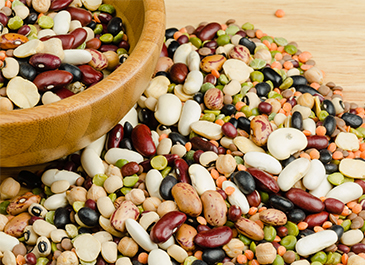A rainbow of colours and nutrients awaits you in the world of legumes: yellow and green split peas, red and black lentils, white cannellini and pink-striped Romano beans. These colours represent some of the antioxidants in legumes, one group of nutrients like protein, fibre, iron and B vitamins that are abundant in beans.
These superfoods should be included in your diet at least three times a week—if not every day—but most of us are depressingly deficient. Plenty of commonly consumed bean dishes can easily become part of your regular rotation. Hummus, for some, is the first step. This Middle Eastern staple is a satisfying dip for pitas, veggies or crackers and can even be used in sandwiches—a much healthier alternative to deli meats. Although pre-made hummus is found in all varieties, it’s also easy to make at home. To ensure the tough chickpea (or garbanzo bean) skins soften enough to purée, add a pinch of baking soda while cooking. Once soft, pop them in the food processor with other healthy ingredients like garlic, tahini, lemon juice, olive oil and a little bit of sea salt and purée until you achieve your desired texture. Refrigerate for an hour to allow flavours to marinate then eat in abundance!
Next, consider a foray into refried beans. It’s often assumed that refried beans are laden with fat, but if you choose a canned version wisely or make them at home, you can guarantee a healthful, Latin-inspired protein source for your burritos, tacos and quesadillas. To whip up refried beans at home, sauté minced garlic in olive oil and, if you like it spicy, add a diced jalapeno. Toss in cooked or canned beans and mash while gradually pouring in hot vegetable stock, preferably low-sodium. Mash and add liquid until your desired consistency is reached. Cook until bubbly then season with ground cumin, fresh lime juice, a splash of soy sauce and/or fresh cilantro.
Canned beans can be convenient, and there are brands that don’t add salt or have BPA in the lining of the can. But, more ideally, cook them from scratch. Here’s an easy time-saving tip: use your slow-cooker. Leave larger beans like kidney or garbanzo to soak in the slow cooker overnight, but don’t turn on the heat until morning. Smaller beans, lentils and split peas can be started on high in the morning. Simply add lots of water and a bay leaf. When you get home at the end of the day, a lovely pot of legumes awaits. Toss them on salad, into a soup or pasta or pile high onto a bowl of rice or quinoa. Aim to cook legumes at least once a week and keep extras in the refrigerator for a quick fix.
The best rebuttal for eating more beans and legumes: they truly are a whole food, picked from a pod and dried to preserve. They are the world’s most affordable protein source, with nothing added and nothing refined…just as nature intended.
To learn more from the Bean Queen, Choices’ Dietitian, Nicole Fetterly, RD, email her at nutrition@choicesmarkets.com.

